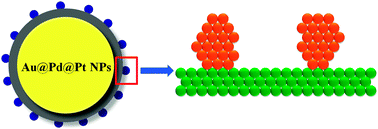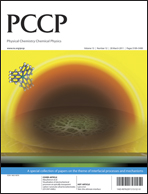Recently, it was found that Pt clusters deposited on Pd shell over Au core nanoparticles (Au@Pd@Pt NPs) exhibit unusually high electrocatalytic activity for the electro-oxidation of formic acid (P. P. Fang, S. Duan, et al., Chem. Sci., 2011, 2, 531–539). In an attempt to offer an explanation, we used here carbon monoxide (CO) as probed molecules, and applied density functional theory (DFT) to simulate the surface Raman spectra of CO at this core-shell-cluster NPs with a two monolayer thickness of Pd shell and various Pt cluster coverage. Our DFT results show that the calculated Pt coverage dependent spectra fit the experimental ones well only if the Pt clusters adopt a mushroom-like structure, while currently the island-like structure is the widely accepted model, which follows the Volmer–Weber growth mode. This result infers that there should be a new growth mode, i.e., the mushroom growth mode as proposed in the present work, for Au@Pd@Pt NPs. We suggest that such a mushroom-like structure may offer novel active sites, which accounts for the observed high electrocatalytic activity of Au@Pd@Pt NPs.

You have access to this article
 Please wait while we load your content...
Something went wrong. Try again?
Please wait while we load your content...
Something went wrong. Try again?


 Please wait while we load your content...
Please wait while we load your content...